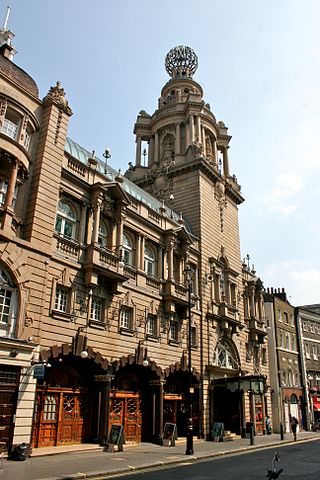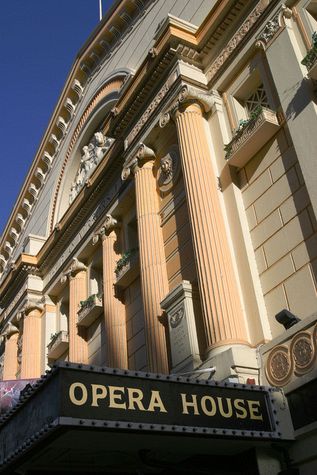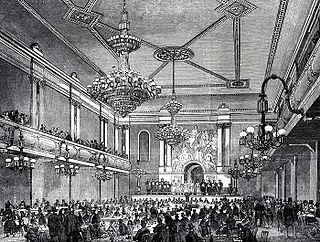
Music hall is a type of British theatrical entertainment that was most popular from the early Victorian era, beginning around 1850, through the Great War. It faded away after 1918 as the halls rebranded their entertainment as variety. Perceptions of a distinction in Britain between bold and scandalous music hall entertainment and subsequent, more respectable variety entertainment differ. Music hall involved a mixture of popular songs, comedy, speciality acts, and variety entertainment. The term is derived from a type of theatre or venue in which such entertainment took place. In North America vaudeville was in some ways analogous to British music hall, featuring rousing songs and comic acts.

The Empire, Leicester Square is a cinema currently operated by Cineworld on the north side of Leicester Square, London, United Kingdom.

The London Coliseum is a theatre in St Martin's Lane, Westminster, built as one of London's largest and most luxurious "family" variety theatres. Opened on 24 December 1904 as the London Coliseum Theatre of Varieties, it was designed by the architect Frank Matcham for the impresario Oswald Stoll. Their ambition was to build the largest and finest music hall, described as the "people's palace of entertainment" of its age.

The Hippodrome is a building on the corner of Cranbourn Street and Charing Cross Road in the City of Westminster, London. The name was used for many different theatres and music halls, of which the London Hippodrome is one of only a few survivors. Hippodrome is an archaic word referring to places that host horse races and other forms of equestrian entertainment.

The Pavilion Theatre is a theatre in Glasgow located on Renfield Street.

The Lyceum is a 1,068-seat theatre in the City of Sheffield, England.

The Alhambra Theatre was a popular theatre and music hall located on the east side of Leicester Square, in the West End of London. It was built as the Royal Panopticon of Science and Arts, opening on 18 March 1854. It was closed after two years for a circus ring to be added, and reopened in April 1858 as the Alhambra. The name was also adopted by many other British music hall theatres located elsewhere: the Alhambra Theatre, Bradford, the Alhambra Theatre Glasgow, etc. The name comes from association with the Moorish splendour of the Alhambra palace in Granada, Spain. The building was demolished in 1936.

The Parc and Dare Hall, now known as the Park and Dare Theatre, is a former Miners' institute but now serves as a large entertainment venue in the village of Treorchy, in the Rhondda Valley of Wales. Since the demolition of the Abercynon Workingmen's Hall, the Parc and Dare Workingmen's Hall is the largest in the South Wales Coalfield. It is a Grade II* listed building.

The Opera House in Quay Street, Manchester, England, is a 1,920-seater commercial touring theatre that plays host to touring musicals, ballet, concerts and a Christmas pantomime. It is a Grade II listed building. The Opera House is one of the main theatres in Manchester. The Opera House and its sister theatre the Palace Theatre on Oxford Street are operated by the same parent company, Ambassador Theatre Group.

The Alhambra Theatre is a theatre in Bradford, West Yorkshire, England, named after the Alhambra palace in Granada, Spain, which was the place of residence of the Emir of the Emirate of Granada. It was built in 1913 at a cost of £20,000 for theatre impresario Francis Laidler, and opened on Wednesday 18 March 1914. In 1964, Bradford City Council bought the Alhambra for £78,900 and in 1974, it was designated a Grade II listed building. It underwent extensive refurbishment in 1986. Today it is a receiving house for large-scale touring theatre of all types and the main house seats 1,456.

The Liverpool Olympia is a venue in Liverpool, England, situated on West Derby Road next to The Grafton Ballroom.

The Canterbury Music Hall was established in 1852 by Charles Morton on the site of a former skittle alley adjacent to the Canterbury Tavern at 143 Westminster Bridge Road, Lambeth. It was one of the first purpose-built music halls in London, and "probably the largest and grandest concert-room ever attached to a public house" in London. Morton came to be dubbed the Father of the Halls as hundreds of imitators were built within the next several years. The theatre was rebuilt three times, and the last theatre on the site was destroyed by bombing in 1942.

The Royal Aquarium and Winter Garden was a place of amusement in Westminster, London. It opened in 1876, and the building was demolished in 1903. The attraction was located northwest of Westminster Abbey on Tothill Street. The building was designed by Alfred Bedborough in an ornamental style faced with Portland stone. The Aquarium Theatre was located in the west end of the building and was renamed the Imperial Theatre in 1879. Methodist Central Hall now occupies the site.

Oxford Music Hall was a music hall located in Westminster, London, at the corner of Oxford Street and Tottenham Court Road. It was established on the site of a former public house, the Boar and Castle, by Charles Morton, in 1861. In 1917 the music hall was converted into a legitimate theatre, and in 1921 it was renamed the New Oxford Theatre. In May 1926 it closed and was demolished.

Everyman Theatre is a theatre based in Regent Street, Cheltenham. There are two auditoria in the building: the 718-seat main auditorium and the 60-seat Studio Theatre, originally named the Ralph Richardson Studio after Ralph Richardson.

John Stanley Coombe Beard FRIBA, known professionally as J. Stanley Beard, was an English architect known for designing many cinemas in and around London.

The former Granada Cinema, also known as the Ebenezer Building or Cathedral of Christ Faith Tabernacle, in Woolwich, South East London, was built as a large and luxurious cinema in the 1930s. It had a seating capacity of nearly 2500 and is now being used as a church hall. The building with its extravagantly decorated interior is a Grade II* listed building.

The Chiswick Empire was a theatre facing Turnham Green in Chiswick that opened in 1912 and closed and was demolished in 1959. A venue for touring artists, some of the greatest names in drama, variety and music hall performed there including George Formby, Laurel and Hardy, Chico Marx, Peter Sellers and Liberace.

The Holborn Theatre was a theatre on High Holborn in London which opened in 1867 as the New Royal Amphitheatre and operated as an equestrian ring and theatre until 1886. During its short existence the theatre underwent numerous name changes, becoming the Holborn Theatre in 1884.

The Grand Theatre was a playhouse in Southampton in Hampshire, England from 1898 until it was demolished in 1960.




















